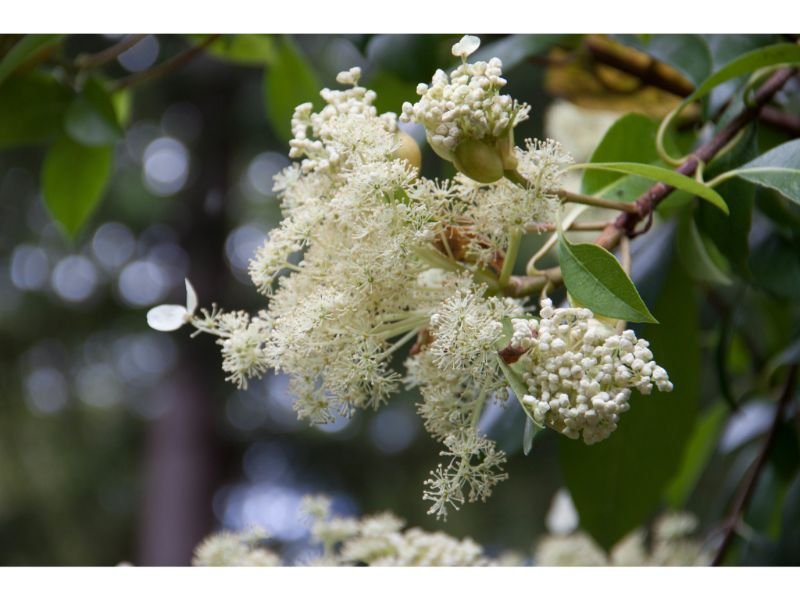Hydrangeas are beloved flowering shrubs that come in a range of colors, sizes, and shapes. Among the various types of hydrangeas, Hydrangea seemannii is a stunning and lesser-known variety that deserves more attention.

In this article, we will share everything you need to know about Seemannii Hydrangea, from its origin and appearance to its growing conditions and care tips. By the end of this article, you’ll have a newfound appreciation for this unique and beautiful plant.
Table of Contents
Introduction to Hydrangea Seemannii
Hydrangea seemannii, also known as Seemann’s hydrangea, is a climbing shrub that belongs to the Hydrangeaceae family. This species is native to the cloud forests of Mexico, where it grows at high altitudes of up to 3,000 meters.
The plant features glossy, dark green leaves that grow up to 15 centimeters long and 8 centimeters wide. Its flowers are arranged in flat-topped clusters called corymbs, which can be up to 30 centimeters in diameter. The flowers are composed of small, creamy-white florets that turn yellowish-green with age.
Growing conditions for Hydrangea Seemannii

Hydrangea seemannii is a hardy and adaptable plant that can thrive in a range of growing conditions. However, it prefers a cool, moist, and shaded environment, similar to its natural habitat in the cloud forests.
The plant is tolerant of various soil types, as long as the soil is well-draining and rich in organic matter. It also prefers slightly acidic soil with a pH range of 5.5 to 6.5.
When it comes to temperature, Hydrangea seemannii can tolerate a range of temperatures but prefers cooler climates. It can withstand temperatures as low as -10 degrees Celsius and as high as 25 degrees Celsius.
How to care for Hydrangea Seemannii
Hydrangea seemannii is a low-maintenance plant that requires minimal care once established. Here are some tips to help you care for your Seemann’s hydrangea:
- Water: Hydrangea seemannii prefers moist soil but can’t tolerate standing water. Water the plant deeply once a week, or more frequently during hot and dry weather.
- Fertilizer: Feed your hydrangea seemannii with a balanced fertilizer in spring and summer to promote healthy growth and flowering.
- Pruning: Prune your Seemann’s hydrangea in late winter or early spring to remove any dead or damaged branches. You can also shape the plant to your liking by selectively pruning the branches.
- Pests and diseases: Hydrangea seemannii is generally free of serious pest and disease problems. However, it can be susceptible to aphids, spider mites, and powdery mildew. Treat any infestations promptly with insecticidal soap or neem oil.
Uses and benefits of Hydrangea Seemannii
Hydrangea seemannii is primarily grown for its ornamental value, as it adds a touch of elegance and beauty to any garden. The plant’s glossy leaves and large, showy flowers make it a popular choice for trellises, arbors, and fences.
Apart from its aesthetic appeal, Hydrangea seemannii also has several potential health benefits. Some studies suggest that the plant contains compounds that have anti-inflammatory, antioxidant, and anti-cancer properties. However, more research is needed to confirm these benefits.
Hydrangea Seemannii toxicity for humans and pets

Seemannii Hydrangea is a beautiful flowering plant that is native to Mexico and Central America. It is a member of the Hydrangeaceae family, which includes other popular garden plants such as hydrangeas and deutzias. While it is a gorgeous plant, there has been some concern over its toxicity to humans and pets.
After extensive research, it has been found that Hydrangea seemannii is not toxic to humans. In fact, it has been used in traditional medicine to treat various ailments such as fever, headaches, and digestive issues. However, caution should still be exercised when handling the plant, as it can cause skin irritation in some individuals.
On the other hand, there is some evidence that suggests Hydrangea seemannii may be toxic to pets, specifically cats and dogs. The plant contains cyanogenic glycosides, which are compounds that release hydrogen cyanide when ingested. Hydrogen cyanide is a potent toxin that can cause serious health issues such as seizures, respiratory failure, and even death.
Symptoms of hydrogen cyanide poisoning in pets can include vomiting, diarrhea, lethargy, confusion, and difficulty breathing. If you suspect that your pet has ingested Hydrangea seemannii, it is crucial to seek veterinary attention immediately. The faster your pet receives treatment, the better their chances of a full recovery.
It is important to note that while Hydrangea seemannii may be toxic to pets, it is not considered a highly toxic plant. The level of toxicity varies depending on the amount ingested and the size and weight of the animal. However, it is always better to err on the side of caution and keep pets away from the plant.
Conclusion
In conclusion, Hydrangea seemannii is a fascinating and stunning plant that deserves more attention. Its glossy leaves, large corymbs of white flowers, and interesting growth habits make it a standout addition to any garden. While it is not toxic to humans, caution should still be exercised when handling the plant due to the potential for skin irritation.
However, pet owners should be aware that Hydrangea seemannii may be toxic to their furry companions. The plant contains cyanogenic glycosides that can release hydrogen cyanide when ingested by pets. If you have pets, it is recommended to keep them away from the plant and seek veterinary attention immediately if you suspect ingestion.
Overall, Hydrangea seemannii is a wonderful plant that can add beauty and interest to any landscape. With proper care and attention, this plant can thrive and bring joy for years to come.

Gardening is my passion and growing plants indoors has always been a stress relief for me. Grow a banana tree in my apartment once (although failed to produce bananas).






